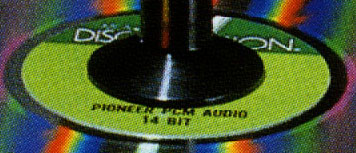 As early as 1979, Pioneer and DiscoVision began to explore the possibilities of encoding digital PCM audio onto
an optical disc. Nearly four years prior to the introduction of the Compact Disc, Pioneer was well into the
research and development of encoding 14-bit PCM audio onto a disc. Even the March 26th, 1980
announcement of Pioneer entering into the consumer videodisc market made mention of "future adapter to play true,
digital ('PCM') audio."
As early as 1979, Pioneer and DiscoVision began to explore the possibilities of encoding digital PCM audio onto
an optical disc. Nearly four years prior to the introduction of the Compact Disc, Pioneer was well into the
research and development of encoding 14-bit PCM audio onto a disc. Even the March 26th, 1980
announcement of Pioneer entering into the consumer videodisc market made mention of "future adapter to play true,
digital ('PCM') audio."
The images here are taken from Pioneer's Annual Report for 1979. The picture to the left shows the industrial
PR-7820 manufactured by Pioneer for MCA DiscoVision. The following quote is taken from the annual report.
The optical videodisc system has won acclaim as a new method of audio visual communication for both the
home and business. Its first successful realization in an industrial configuration is the MCA DiscoVision Model
PR-7820 optical video disc player. Incorporating a microprocessor, this player was developed by Universal
Pioneer Corporation, a joint venture between Pioneer and MCA, in the fall of 1978. Already, more than 10,000
DiscoVision units have been shipped to General Motors through MCA. The DiscoVision player employs a unique non-
contact technique: instead of a stylus, a laser beam is used to "pick up" audio and video information from a disc
which stores 54,000 frames per side. In addition to such features as random access and still-pictures or slow-
motion image rendition, it offers both high picture and sound quality. Since two channels are used to relay
sound, there is a choice of stereo or bilingual reproduction.

The image on the right is a "blow-up" of the disc mounted in the player on the left. The label clearly shows
that testing and prototypes had begun in encoding PCM Digital audio onto the 12" optical disc platform. Had the
Compact Disc not been launched, Digital audio would more than likely have been released to the public through the
laserdisc medium.
Updated: November 5, 1996
 As early as 1979, Pioneer and DiscoVision began to explore the possibilities of encoding digital PCM audio onto
an optical disc. Nearly four years prior to the introduction of the Compact Disc, Pioneer was well into the
research and development of encoding 14-bit PCM audio onto a disc. Even the March 26th, 1980
announcement of Pioneer entering into the consumer videodisc market made mention of "future adapter to play true,
digital ('PCM') audio."
As early as 1979, Pioneer and DiscoVision began to explore the possibilities of encoding digital PCM audio onto
an optical disc. Nearly four years prior to the introduction of the Compact Disc, Pioneer was well into the
research and development of encoding 14-bit PCM audio onto a disc. Even the March 26th, 1980
announcement of Pioneer entering into the consumer videodisc market made mention of "future adapter to play true,
digital ('PCM') audio."
